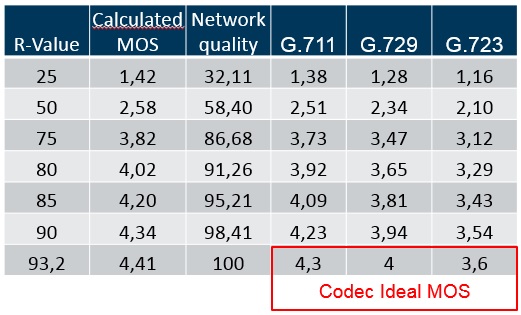MOS
(Work in progress) |
(MOS ingress-egress) |
||
| Line 11: | Line 11: | ||
=== TelcoBridges' MOS Implementation === | === TelcoBridges' MOS Implementation === | ||
| − | On the MOS calculated from the R-value, there is no notion of codec. We decided to apply a ratio in relation to the codec ideal MOS. | + | On the MOS calculated from the R-value, there is no notion of codec. We decided to apply a ratio in relation to the codec ideal MOS. |
| + | |||
An illustration is provided below: | An illustration is provided below: | ||
| Line 17: | Line 18: | ||
[[Image:mos_codec_conversion.jpg| ]]<br> | [[Image:mos_codec_conversion.jpg| ]]<br> | ||
| − | Network quality | + | ==== Network quality ==== |
TelcoBridges' MOS implementation adds an other concept over the standard MOS. The network quality gives a fast way to identify a bad network condition. The MOS is useful when comparing calls for the same [[NAP]] or on the same network but if you are using several codecs. The MOS value might be misleading to detect network problems. | TelcoBridges' MOS implementation adds an other concept over the standard MOS. The network quality gives a fast way to identify a bad network condition. The MOS is useful when comparing calls for the same [[NAP]] or on the same network but if you are using several codecs. The MOS value might be misleading to detect network problems. | ||
| − | A perfect network (no packet loss, no latency) using G.723 will have a MOS of 3.6. This represents a network quality of 100%. The only way to improve the situation will be to use an other codec. | + | *'''Examples:''' |
| + | **A perfect network (no packet loss, no latency) using G.723 will have a MOS of 3.6. This represents a network quality of 100%. The only way to improve the situation will be to use an other codec. | ||
| + | **A G.711 call with a MOS of 3.7 represents a network quality of 86%. With these values, you know there is something that can be improved in the network. | ||
| + | |||
| + | |||
| + | ==== Ingress-Egress ==== | ||
| + | There is 2 MOS values calculated per leg of a call. The ingress value is using RTP reception statistics and the egress value is using RTCP statistics from the peer. Both values have the network quality value associated. | ||
| + | When using [[Call_Trace|Call Trace]] the lowest value between the ingress and the egress MOS is visible in the resume. | ||
| − | + | [[Category:Glossary]] | |
| + | [[Category:Sbc_Features]] | ||
Revision as of 11:31, 17 January 2018
Mean Opinion Score, more commonly known as MOS, is a voice call quality metric range from 5 (excellent) to 1 (bad). It is a subjective method of quality assessment.
Contents |
TelcoBridges and MOS
Toolpack uses a well known model to evaluate a MOS value based on metric of the call. There is 3 factors that significantly impact the call quality: latency, packet loss and jitter of RTP packets. With these values with calculate a R-value that ranges from 1 to 100 where the higher means better. Finally the MOS is calculated using this formula.
MOS = 1 + 0.035R + ((R - 60) * (100 – R) * 0.000007R)
TelcoBridges' MOS Implementation
On the MOS calculated from the R-value, there is no notion of codec. We decided to apply a ratio in relation to the codec ideal MOS.
An illustration is provided below:
Network quality
TelcoBridges' MOS implementation adds an other concept over the standard MOS. The network quality gives a fast way to identify a bad network condition. The MOS is useful when comparing calls for the same NAP or on the same network but if you are using several codecs. The MOS value might be misleading to detect network problems.
- Examples:
- A perfect network (no packet loss, no latency) using G.723 will have a MOS of 3.6. This represents a network quality of 100%. The only way to improve the situation will be to use an other codec.
- A G.711 call with a MOS of 3.7 represents a network quality of 86%. With these values, you know there is something that can be improved in the network.
Ingress-Egress
There is 2 MOS values calculated per leg of a call. The ingress value is using RTP reception statistics and the egress value is using RTCP statistics from the peer. Both values have the network quality value associated.
When using Call Trace the lowest value between the ingress and the egress MOS is visible in the resume.
